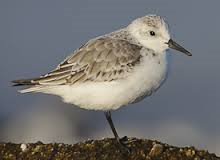When asked to expand upon a passage in Rachel Carson’s Under the Sea-Wind, I was more than a little apprehensive as I was mistakenly passing the time with Sarah Orne Jewett (sorry Rachel). However, I tried my best without any context. The passage that I chose to examine is located on page twenty-four and goes as follows:
“After the tide turned, the water pressed stronger from the sea. The waves came in with a deeper swell and a heavier crash, warning the sanderlings that feeding on the ocean beach was no longer safe. The flock wheeled out over the sea, with a flashing of the white wing bars that distinguished them from other sandpipers. They flew low over the crests of waves as they traveled up the beach. So they cam to the point of land called the Ship’s Shoal, where the sea had broken through the barrier island to the sound years before.”
The phrase ” a deeper swell and heavier crash” led me to believe that the ocean is being depicted as a dangerous entity that is to be feared by the life it sustains, such as the sandpipers. This depiction is reinforced when Carson describes Ship’s Shoal, “where the sea had broken through the barrier island to the sound years before.” From this phrase I can gather that the ocean is strong, and it is violent.
As much as it is violent, the sea is unpredictable. One moment it may be sustaining the life of the sanderlings, and the next it may be endangering it; the sea is “no longer safe” for them. Though this is the case, the sanderlings are still perfectly at home with the ocean. They “flew low over the crests of waves” in a familiar way; this danger is not out of the ordinary for them.
Also, if anyone else was wondering what a sanderling actually looks like, there is a picture below. Imagine this little guy going up against massive waves in the ocean!

